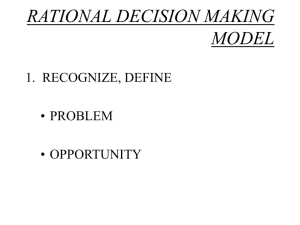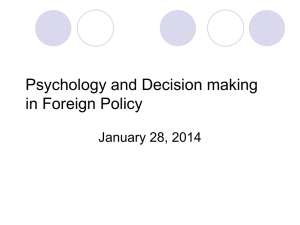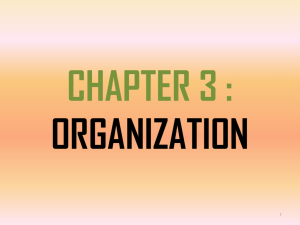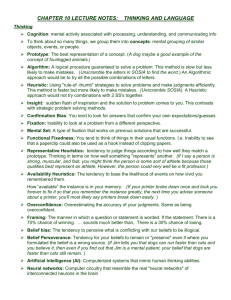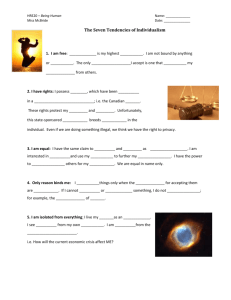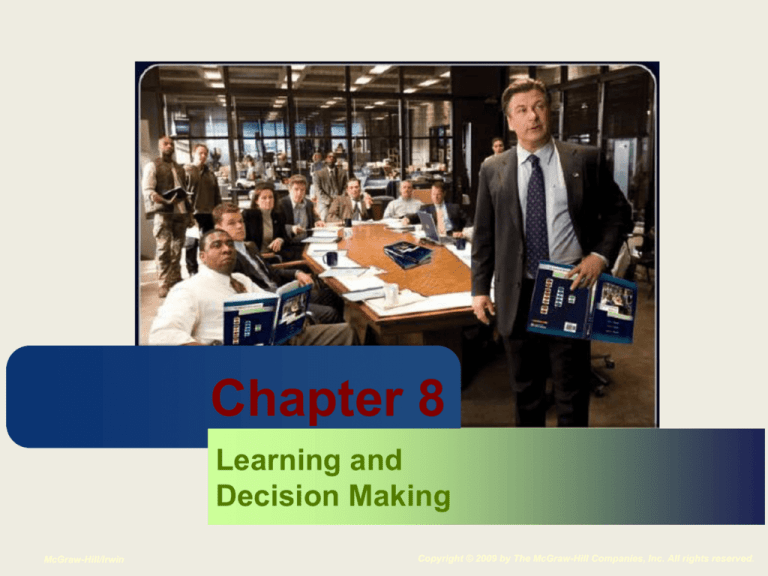
Chapter 8
Learning and
Decision Making
McGraw-Hill/Irwin
Copyright © 2009 by The McGraw-Hill Companies, Inc. All rights reserved.
Learning Goals
• What is decision making?
• What types of knowledge correspond to what
types of decision making?
• What methods can employees use to make
decisions?
• What decision-making problems can prevent
employees from translating their learning into
accurate decisions?
• How does learning affect job performance and
organizational commitment?
Learning and Decision Making
• Learning reflects relatively permanent changes in an
employee’s knowledge or skill that result from
experience.
– We learn through reinforcement (rewards and punishment),
observation, experience, logic and cognition.
• Decision making refers to the process of generating
and choosing from a set of alternatives to solve a
problem.
– The more knowledge and skills employees possess, the
more likely they are to make accurate and sound decisions
and provide the organization with a sustaining resource.
• Expertise refers to the knowledge and skills that
distinguish experts from novices and less experienced
people.
Discussion Questions
• What does the term “expert” mean to
you?
• What exactly do experts do that novices
don’t?
Types of Knowledge
• Explicit knowledge is the kind of information
you are likely to think about when you picture
someone sitting down at a desk to learn.
– Relatively easily communicated.
• Tacit knowledge is what employees can
typically learn only through experience.
– Up to 90 percent of the knowledge contained in
organizations occurs in tacit form.
Table 8-1
Characteristics of Explicit and Tacit
Knowledge
The Decision-Making Process
Programmed Decision – a simple, routine
matter for which a manager has an
established decision rule
Nonprogrammed Decision – a new, complex
decision that requires a creative solution
Models of Decision Making
Effective
Decision
a timely decision
that meets a
desired objective
and is acceptable
to those
individuals
affected by it
Rational
Bounded Rationality
Intuitive
Rational Model
Rationality – a logical, stepby-step approach to decision
making, with a thorough analysis
of alternatives and their
consequences
1. The outcome will be completely rational
2. The decision maker uses a consistent system of
preferences to choose the best alternative
3. The decision maker is aware of all alternatives
4. The decision maker can calculate the probability of success
for each alternative
Copyright ©2006
by South-Western,
a division of
Thomson Learning.
All rights reserved
Single Attribute Rational Process
• Exact like options that are
compared. (Commodities)
• Decision usually based on best
price.
Multi-Attribute Choice in Rational Decision
Making
• Outcomes can not be scaled along a
single metric (e.g. $, style, utility, etc.)
• Compensatory Strategies (e.g. Linear
Model)
• Non-Compensatory Strategies (e.g.
Lexicographic)
Example of Linear Model
Step 1: Identify and Diagnose the Problem:
Which Truck to Buy? What are the decision
criteria?
•Styling
•Color
•Bed
•Wheels
•Engine/Economy
•Crash Rating
•Resale Value
Linear Model Continued
Weigh the Criteria
(Scale of 1-5)
Styling
5
Color
3
Bed
4
Wheels
3
Engine/Economy
2
Crash Rating
1
Resale Value
2
Linear Model Continued
Step 2: Generate Alternatives: Ford or
Chevy
Step 3: Evaluate the Alternatives on Each
Criterion
Ford Pickup
1-10 Scale
Chevy Pickup
Styling
6
Styling
10
Color
10
Color
5
Bed
5
Bed
10
Wheels
10
Wheels
3
Engine/Economy
5
Engine/Economy
8
Crash Rating
7
Crash Rating
5
Resale Value
5
Resale Value
7
Linear Model Continued
Step 4: Chose the Optimal Decision:
Ford Pickup
Rating X Weight
Styling
6
X
5
= 30
Color
10
X
3
= 30
Bed
5
X
4
= 20
Wheels
10
X
3
= 30
Engine/Economy
5
X
2
= 10
Crash Rating
7
X
1
= 7
Resale Value
5
X
2
= 10
TOTAL
137
Linear Model Continued
Chevy Pickup
Rating X Weight
Styling
10
X
5
= 50
Color
5
X
3
= 15
Bed
10
X
4
= 40
Wheels
3
X
3
= 9
Engine/Economy
8
X
2
= 16
Crash Rating
5
X
1
= 5
Resale Value
7
X
2
= 14
TOTAL
149
Lexicographic Decision Model
• Identify the most important dimension for
comparison.
– Color of Car
• Chose the most desirable alternative for this
comparison.\
– Red!
• Eliminate alternatives that don’t meet the criteria.
– Only cars A, D and E qualify.
• Identify the next most important dimension and
begin process again.
Assumptions of the Rational
Decision Making Process
• The problem is clear and unambiguous.
• There is a single, well-defined goal that all
parties agree to.
• Full information is available about criteria.
• All the alternatives and their consequences
are known.
McGraw-Hill
© 2004 The McGraw-Hill Companies, Inc. All rights reserved.
Assumptions of the Rational
Decision Making Process (continued)
• The decision preferences are clear.
• The decision preferences are constant and
stable over time.
• There are no time and cost constraints
affecting the decision.
• The decision solution will maximize the
economic payoff.
McGraw-Hill
© 2004 The McGraw-Hill Companies, Inc. All rights reserved.
Limitations of Rational Model
•May take too much time to chose
alternatives and evaluate, thus losing
opportunity window.
•Poor information may cause the wrong
alternatives to be evaluated, or viable
alternatives may not be considered.
•Complexity of problem may preclude
evaluation with rational model.
•Most decisions are made with:
Incomplete information (uncertainly)
Unforeseen outcome results (risk)
Factors That Limit the Validity of Rational
Decision Making
Bounded Rationality: Simplification of complex decisions
that extract essential features of the problem, gravitating
the decision maker to the first acceptable alternative
(Satisficing).
Problem Identification: Some managers may be willing to
live with a situation that others might consider to be a
problem.
Heuristics: Human tendency to trust general rules of
thumb that reduce mental work-loads, works most of the
time but can lead to systematic biases.
Emotions: Depression, anxiety, anger, frustration.
Political Influences: Group dynamic, organizational
influence.
Individual Differences: Tolerance for Ambiguity, Intuitive
Level, Tolerance for Risk and Illusion of Control.
McGraw-Hill
Culture: The native culture of nationality.
© 2004 The McGraw-Hill Companies, Inc. All rights reserved.
Heuristics Test #1
• Linda is 31 years old, single, outspoken and very
bright. She majored in philosophy. As a student, she
was deeply concerned with issues of discrimination
and social justice, and also participated in
antinuclear demonstrations. What is the most likely
alternative?
Linda is a bank teller.
Linda is a bank teller and is active in the feminist
movement.
Heuristics Test #2
• If you were faced with the following
choice, which alternative would you
chose?
A 100% chance of losing $500
A 25% chance of losing $2000 and a
75% chance of losing nothing
Heuristics Test #3
• Which is a more likely cause of death in
the United States—being killed by beach
sand holes or by a shark?
Beach Sand Holes
Shark Attack
Heuristics Test #4
• The mean IQ of the population of eighth
graders in a city is known to be 100. You have
selected a random sample of 50 children for a
study of educational achievements. The first
child test has an IQ of 150. What do you
expect the mean IQ to be for the whole
sample?
Decision-Making Biases
Table 8-4
Name of Bias
Description
Anchoring
The tendency to rely too heavily, or “anchor,” on one trait or
piece of information when making decisions.
Availability bias
A biased prediction, due to the tendency to focus on the most
salient and emotionally charged outcome.
Bandwagon effect
The tendency to do (or believe) things because many other
people do (or believe) the same.
Choice-supportive bias
The tendency to remember one’s choices as better than they
actually were.
Confirmation bias
The tendency to search for or interpret information in a way
that confirms one’s preconceptions.
Contrast effect
The enhancement or diminishment of a weight or other
measurement when compared with recently observed
contrasting object.
False consensus effect
The tendency for people to overestimate the degree to which
others agree with them.
Decision-Making Biases, Cont’d
Table 8-4
Name of Bias
Description
Gambler’s fallacy
The tendency to assume that individual random events are
influenced by previous random events.
Halo effect
The tendency for a person’s positive or negative traits to “spill
over” from one area of their personality to another in others’
perceptions of them.
Hindsight bias
Sometimes called the “I-knew-it-all-along” effect, the inclination to
see past events as being predictable.
Illusion of control
The tendency for human beings to believe they can control or at
least influence outcomes that they clearly cannot.
Primacy effect
The tendency to weigh initial events more than subsequent
events.
Projection bias
The tendency to unconsciously assume that others share the
same or similar thoughts, beliefs, values, or positions.
Recency effect
The tendency to weigh recent events more than earlier events.
Self-fulfilling
prophecy
The tendency to engage in behaviors that elicit results that will
(consciously or subconsciously) confirm our beliefs.
How Can We Overcome Heuristic
Limitations?
Don’t be misled by highly detailed scenarios. The very specificity
that makes detailed scenarios seem representative also decreases
their likelihood.
Pay attention to base rates. A base rate is the relative frequency
with which an event occurs. Base rates are particularly important
when an event is very rare or very common.
Except for extreme probabilities people naturally are risk taking
to avoid losses, risk averse toward possible gains. Temper your
risk instinct by realistically evaluating the probabilities involved in an
event and use risk valuation calculations to help you assess.
Remember that chance is not self-correcting. A run of bad luck
does not mean that an equalizing run of good luck is about to occur.
Compare the frequency of uncommon events with more well
known events to gain event frequency perspective.
Be aware of any suggested values that seem unusually high or
low. These are anchor values that most likely produce biases in
judgment.
Non-Rational Decision Models Allow Good
Decisions to be Made Quickly
Intuition involves the recognition of
patterns and outcomes that would not
be clear otherwise.
•Gained through experience.
•Employs acquired expertise.
Satisficing is the selection of the first
available alternative that appears to
be satisfactory.
Bounded Rationality
Model
Bounded Rationality – a
theory that suggests that
there are limits upon how
rational a decision maker
can actually be
1. Managers suggest the first satisfactory
alternative
Satisfice – to select the first alternative that is “good
enough,” because the costs in time and effort are
too great to optimize
Copyright ©2006
by South-Western,
a division of
Thomson Learning.
All rights reserved
Bounded Rationality
Model
Bounded Rationality – a
theory that suggests that
there are limits upon how
rational a decision maker
can actually be
1. Managers suggest the first satisfactory
alternative
2. Managers recognize that their conception
of the world is simple
3. Managers are comfortable making decisions
without determining all the alternatives
4. Managers make decisions by rules of thumb
or heuristics—CAUTION!!!!
Copyright ©2006
by South-Western,
a division of
Thomson Learning.
All rights reserved
Heuristics – shortcuts in decision
making that save mental activity
BUT MAY CREATE BIASES
Intellective & Judgmental Decision
Types
• Intellective decisions are those in which you
can logically demonstrate a correct answer.
Example: Solution to a puzzle.
• Judgmental decisions are those in which an
absolutely correct answer can not be
demonstrated.
Example: Prediction of style trends.
Rationality or Intuition?
Use BOTH, but ….
• Rely on rationality primarily in an intellective
decision.
• Rely on intuition primarily in a judgmental
decision.
Z Problem-Solving Model
Look at
the facts
and details
Can it be
analyzed
objectively?
Sensing
Thinking
Copyright ©2006
by South-Western,
a division of
Thomson Learning.
All rights reserved
What alternatives
Intuition
do the facts
suggest?
Feeling
What impact
will it have on
those involved?
Figure from Type Talk at Work by Otto Kroeger and Janet M. Thuesen. Copyright © 1992 by Otto Kroeger
and Janet M. Thuesen. Used by permission of Dell Publishing, a division of Random House. Inc.
Risk and the Manager
Risk Aversion – the tendency to choose options
that entail fewer risks and less uncertainty
Risk takers
– accept greater potential for loss
– tolerate greater uncertainty
– more likely to make risky decisions
Evidence: Successful Managers Take Risks
Framing and the Perception of Risk
How would you respond to the following
decision?
• If program A is adopted, 200 people will be
saved.
• If program B is adopted, there is a 1/3
probability that 600 people will be saved and
2/3 probability that no people will be saved.
Framing and the Perception of Risk
(con’t)
How would you respond to this decision?
• If program X is adopted, 400 people will die.
• If program Y is adopted, there is a 1/3
probability that no people will die and 2/3
probability that 600 people will die.
Escalation of
Commitment
The tendency to continue
to commit resources to a
failing course of action
• Why it occurs
–
–
–
–
humans dislike inconsistency
optimism
control
sunk costs
• How to deal with it
– split responsibility for decisions
– provide individuals with a graceful exit
– have groups make the initial decision
Cognitive Style
Cognitive Style – an individual’s
preference for gathering information
and evaluating alternatives
Jungian theory offers a way of
understanding and appreciating
differences among individuals.
Jung’s Cognitive Style
Style
Favored Process
ST
Sensing/thinking
Facts/ Impersonal Analysis
SF
Sensing/feeling
Facts & Org. Relationships
NT
NF
Intuiting/thinking Broad Issues/ Impersonal & Ideal
Intuiting/feeling
Copyright ©2006
by South-Western,
a division of
Thomson Learning.
All rights reserved
Serve Humankind/General Values
Two Brains, Two Cognitive Styles
Left Hemisphere
Right Hemisphere
Verbal
Sequential, temporal,
digital
Logical, analytic
Rational
Western thought
Copyright ©2006
by South-Western,
a division of
Thomson Learning.
All rights reserved
Nonverbal, visuospatial
Simultaneous, spatial,
analogical
Gestalt, synthetic
Intuitive
Eastern thought
Ideal = “brain-lateralized” making use of
either or both sides, depending on situation
From Left Brain, Right Brain by Springer and Deutsch © 1989, 1985, 1981 by Sally Springer and Georg Deutsch.
Used with permission by W.H. Freeman and Company
Influences on Decision Making
Intuition – fast,
positive force in
decision making
utilized at a level
below consciousness,
involves learned
patterns of
information
Creativity – a process
influenced by
individual and
organizational factors
that results in the
production of novel
and useful ideas,
products, or both
Participative
Decision Making
Individuals who are
affected by decisions
influence the making
of those decisions
• Organizational Foundations
– Participative, supportive organizational culture
– Team-oriented work design
• Individual Prerequisites
– Capability to become psychologically involved in
participative activities
– Motivation to act autonomously
– Capacity to see the relevance of participation for
one’s own well-being
Group Decision Making
• Role of synergy – a positive force that occurs in
groups when group members stimulate new
solutions to problems through the process of
mutual influence and encouragement in the
group
• Role of social decision schemes – simple rules
used to determine final group decisions
Majority Wins
Truth Wins
Two-thirds Majority
Group Decision Making Dynamics
Complex,
Ambiguous
Problem
Judgmental
Decision
•May require
compromise, but too
much compromise
may dilute an
effective decision.
•Hard to satisfy all
parties.
•Majority rules.
Clear Cut Logical
Problem
Intellective
Decision
•Shoot for high
consensus.
•“Truth Wins”
eventually.
•2/3rds plurality or
unanimous
decisions.
Group Phenomenon
Groupthink – a deterioration of mental efficiency,
reality testing, and moral judgment resulting
from in-group pressures
Group Polarization – the tendency for group
discussion to produce shifts toward more
extreme attitudes among members
Preventing Groupthink
• Ask each group member to act as critical
evaluator
• Have the leader avoid stating his opinion
prior to the group decision
• Create several groups to work
simultaneously
• Appoint a devil’s advocate
• Evaluate the competition carefully
• After consensus, encourage rethinking the
position
From Janis, Irving L., Groupthink: Psychological Studies of Policy Decisions and Fiascoes, Second Edition. Copyright
© 1982 by Houghton Mifflin Company.
Ethics Check
• Is it legal?
– Does it violate law
– Does it violate
company policy
• Is it balanced?
– Is it fair to all
– Does it promote win–win relationships
• How will it make me feel about myself
Copyright ©2006
by South-Western,
a division of
Thomson Learning.
All rights reserved


